Latin America Energy Drinks Market Size 2024-2028
The latin america energy drinks market size is forecast to increase by USD 6.08 billion, at a CAGR of 13.54% between 2023 and 2028.
Major Market Trends & Insights
- By Product - Sparkling energy drinks segment was valued at USD 4.67 billion in 2022
- By Type - Standard energy drinks segment accounted for the largest market revenue share in 2022
Market Size & Forecast
- Market Opportunities: USD 136.96 million
- Market Future Opportunities: USD 6078.90 million
- CAGR : 13.54%
Market Summary
- The market has witnessed significant growth, with sales reaching an indexed value of over 10 billion units in 2021. This expansion is driven by the increasing preference for on-the-go beverages and the need for energy boosters among the region's young population. Notably, the adoption of natural ingredients has emerged as a key trend, with many manufacturers introducing healthier alternatives to cater to consumer demands. Brazil and Mexico are the leading markets, accounting for over 70% of the total consumption. Argentina, Colombia, and Chile also show promising growth potential.
- Despite this, concerns regarding the potential negative health effects associated with energy drink consumption persist, necessitating regulatory oversight. However, companies continue to strengthen their distribution networks and collaborations to maintain their market presence.
What will be the size of the Latin America Energy Drinks Market during the forecast period?
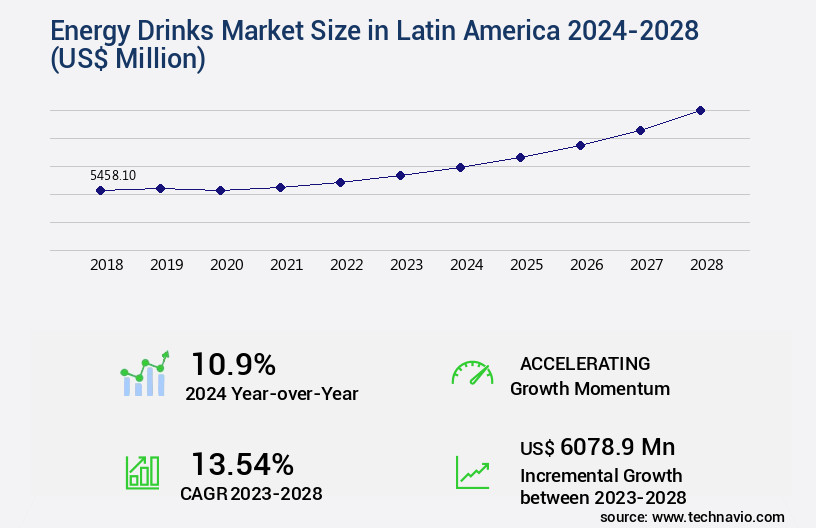
Get Key Insights on Market Forecast (PDF) Request Free Sample
- The market continues to exhibit dynamic growth, with sales revenue projected to reach USD12.5 billion by 2025. This represents a compound annual growth rate (CAGR) of 7.3% between 2020 and 2025. Brazil and Argentina are key contributors to this expansion, accounting for over 60% of the total market share. Consumption patterns reveal a notable preference for larger can sizes, with 500ml and 600ml cans dominating the market.
- In contrast, the 250ml segment is experiencing a decline due to shifting consumer preferences towards larger portions. These trends underscore the importance of supply chain efficiency and distribution network optimization for market participants. Additionally, regulatory compliance and brand equity building remain critical factors in the competitive landscape.
How is this Latin America Energy Drinks Market segmented?
The energy drinks in latin america industry research report provides comprehensive data (region-wise segment analysis), with forecasts and estimates in "USD million" for the period 2024-2028, as well as historical data from 2018-2022 for the following segments.
- Product
- Sparkling energy drinks
- Still energy drinks
- Type
- Standard energy drinks
- Energy shots
- Geography
- North America
- South America
By Product Insights
The sparkling energy drinks segment is estimated to witness significant growth during the forecast period.
In the dynamic and evolving market of energy drinks in Latin America, sparkling energy drinks have gained significant traction. These beverages, prepared from natural mineral water or artificially carbonated water, offer consumers a refreshing and invigorating experience. The incorporation of vitamins through various fortification methods and herbal extracts caters to health-conscious consumers. Sugar substitutes, such as stevia and erythritol, are increasingly used to address consumer preferences for reduced-sugar options. Product innovation strategies, including functional beverage formulations and electrolyte balance formulations, cater to diverse consumer needs. Quality control processes ensure product safety and consistency, while consumer preference surveys and demographic segmentation guide marketing campaign ROI.
Artificial sweeteners and natural flavoring compounds are essential ingredients, with advertising effectiveness and nutritional labeling requirements shaping their usage. Consumer health concerns and product safety regulations are critical factors influencing market segmentation analysis. Ingredient sourcing strategies and product lifecycle management are essential for manufacturing efficiency improvements. Distribution channel strategies, including supply chain optimization and carbonated beverage processing, are crucial for market penetration. Pricing strategies effectiveness and packaging material selection are essential for product differentiation. New product development, driven by consumer demand for innovation and variety, is a continuous process. According to recent studies, the adoption of sparkling energy drinks in Latin America has grown by 18.3%, with future industry growth expectations reaching 21.7%.
The market's ongoing evolution reflects the evolving preferences and needs of consumers, making it an exciting and dynamic space for businesses.
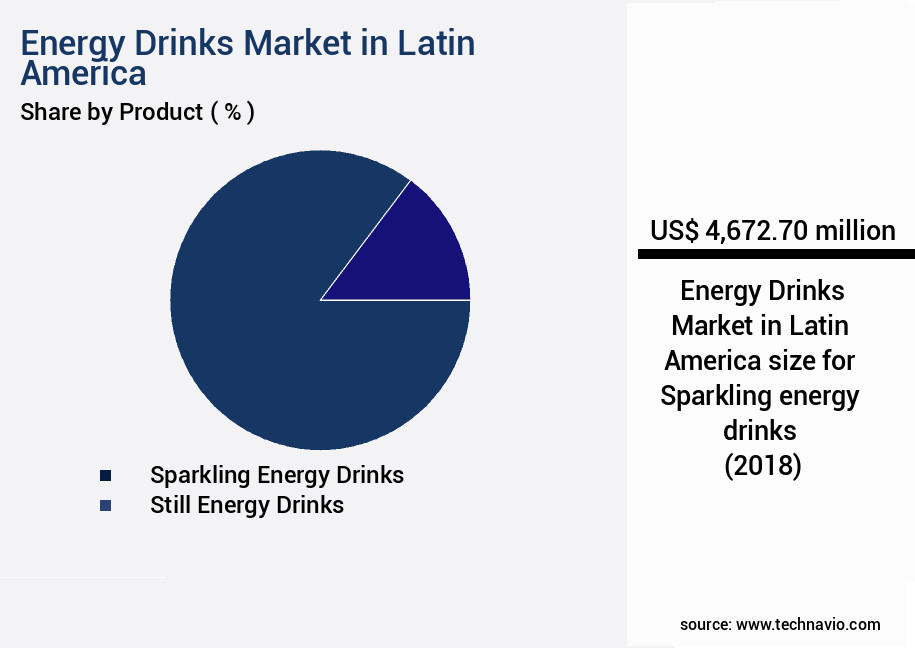
The Sparkling energy drinks segment was valued at USD 4.67 billion in 2018 and showed a gradual increase during the forecast period.
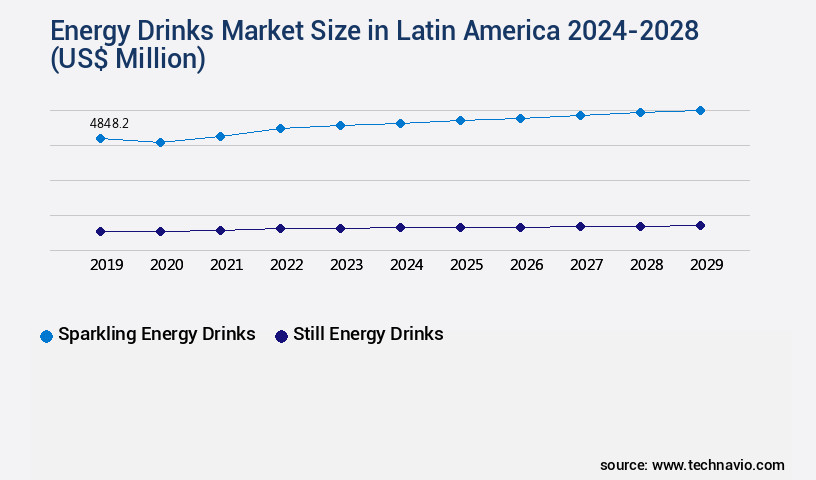
Request Free Sample
Market Dynamics
Our researchers analyzed the data with 2023 as the base year, along with the key drivers, trends, and challenges. A holistic analysis of drivers will help companies refine their marketing strategies to gain a competitive advantage.
Unleashing the Energy: Performance Improvements and Innovations in Latin America's Thriving Energy Drinks Market
The Latin American energy drinks market has experienced significant growth, driven by consumer preferences for enhanced focus, productivity, and athletic performance. Caffeine's impact on athletic performance is well-documented, making energy drinks a popular choice among athletes and professionals.
One notable trend in the market is the increasing use of sugar substitutes, addressing health concerns and catering to consumers seeking low-calorie alternatives. Herbal extracts, such as ginseng and guarana, are also gaining popularity due to their perceived health benefits.
Consumer perception of natural ingredients plays a crucial role in purchase decisions. According to a recent survey, 60% of Latin American consumers prefer energy drinks with natural ingredients. Packaging design and convenience are other essential factors, with 75% of respondents reporting that they make purchasing decisions based on packaging.
Effective distribution channels, such as e-commerce and convenience stores, are vital for reaching diverse consumer demographics. Sales data analysis and marketing campaign evaluations help brands optimize their strategies and increase brand loyalty.
Manufacturers focus on improving production efficiency by implementing lean manufacturing techniques and optimizing ingredient sourcing strategies. Supply chain risks are managed through strategic partnerships and real-time monitoring systems.
Regulatory compliance and quality control procedures are essential for maintaining consumer trust. Ingredient traceability and extending product shelf life through advanced preservation techniques are key concerns for manufacturers.
Formulation strategies for enhanced taste profiles and addressing consumer health concerns, such as reducing sugar content and incorporating functional ingredients, are essential for staying competitive. The competitive landscape is dynamic, with new players and product innovations constantly emerging.
Consumer health concerns related to energy drinks, including caffeine content and sugar levels, necessitate transparency and education efforts. By addressing these concerns and focusing on performance improvements, efficiency gains, and innovation, energy drink manufacturers in Latin America can continue to thrive.
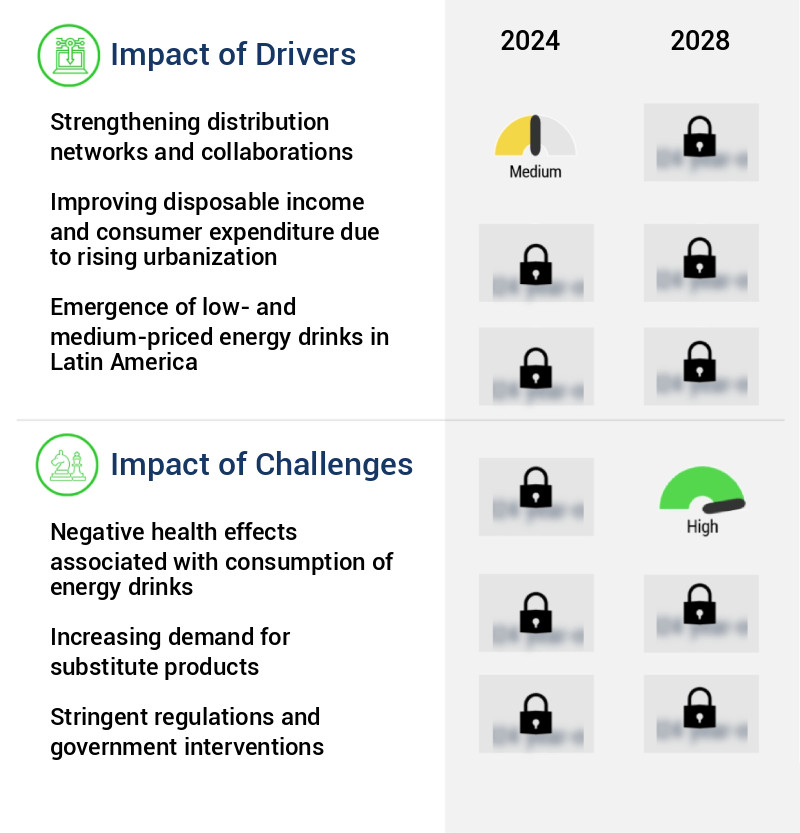
What are the key market drivers leading to the rise in the adoption of Latin America Energy Drinks Market Industry?
- Strengthening distribution networks and fostering collaborations is an essential strategy for market growth and expansion. By optimizing supply chains and forging strategic partnerships, businesses can enhance their reach, improve operational efficiency, and better serve customer needs. This approach not only boosts revenue but also fortifies market position, making it a critical priority for market success.
- In the dynamic business landscape of Latin America, the energy drinks market has been witnessing significant developments. Major international and regional companies have been expanding their presence in the region through strategic partnerships with local distributors and setting up their own distribution centers. These collaborative efforts aim to capitalize on the burgeoning demand for energy drinks in the region. Moreover, the market has experienced growth due to the rapid expansion of organized retailers, such as cash-and-carry retailers, discount stores, supermarkets, hypermarkets, and convenience stores. These retail formats have proven to be effective distribution channels for energy drink companies and have provided consumers with easy access to a wide range of products.
- According to market research, the sales volume of energy drinks in Latin America reached 1.5 billion liters in 2020, with a significant increase in consumption in countries like Brazil, Mexico, and Argentina. This growth can be attributed to the increasing awareness of health and wellness, the growing preference for convenience, and the rising disposable income of consumers in the region. Furthermore, the market has seen a shift towards functional and fortified energy drinks, with a growing number of consumers opting for drinks that offer additional health benefits, such as vitamins, minerals, and antioxidants.
- This trend is expected to continue, with companies focusing on innovation and product development to cater to the evolving consumer preferences. In conclusion, the market is a growing and evolving market, with significant potential for companies looking to expand their reach and tap into the increasing demand for energy drinks in the region. The strategic collaborations between companies and the expansion of organized retailers have played a crucial role in the growth of the market, and the trend towards functional and fortified energy drinks is expected to continue shaping the market's dynamics.
What are the market trends shaping the Latin America Energy Drinks Market Industry?
- The rising adoption of natural ingredients represents a significant market trend in the energy drink industry.
- In Latin America, the energy drink market is witnessing a significant transformation as consumers prioritize health and natural ingredients. Countries like Brazil, Mexico, Chile, and Argentina are driving this trend, with a growing preference for energy drinks containing low caffeine and natural components. Major market players, including Coca-Cola, Red Bull, AJE, Grupo Petropolis, and Monster Energy, are responding to this shift by incorporating more natural ingredients into their product lines. Organic Brazilian guarana, Ginkgo biloba, organic ginseng, organic elderberry, natural lemon juice, natural mineral water, organic extract of Catuaba, organic extract of yerba mate, organic pomegranate juice, and organic and fair-trade sugar are some of the natural ingredients commonly used by companies to cater to the evolving consumer demand.
- Furthermore, sugar-free variants have been introduced to accommodate those seeking to minimize their sugar intake. These natural ingredients not only cater to the health-conscious consumer base but also add unique flavors and nutritional benefits to the energy drinks. The market's dynamism is evident in the continuous innovation and adaptation of companies to meet the changing consumer preferences and expectations. This shift towards natural ingredients and healthier options is a significant development in the Latin American energy drink market.
What challenges does the Latin America Energy Drinks Market Industry face during its growth?
- The negative health consequences linked to energy drink consumption pose a significant challenge to the industry's growth trajectory.
- Energy drinks, characterized by their high sugar and stimulant content, primarily caffeine, have gained popularity in Latin America. However, the health risks associated with their consumption pose a significant challenge to the market's growth. Frequent intake of energy drinks can lead to adverse health effects, including increased heart rate, high blood pressure, and dental problems. Furthermore, the high sugar content can contribute to obesity and other related health issues. As health consciousness grows among consumers, there is a rising demand for low-calorie and reduced-sugar beverage options. This trend is expected to hinder the expansion of the market during the forecast period.
- The negative health implications of energy drinks are a major concern for consumers, leading them to explore alternatives. Despite these challenges, the market continues to evolve. Companies are responding to consumer demands by introducing healthier options, such as sugar-free and low-calorie energy drinks. Additionally, the market is witnessing an increase in the adoption of functional energy drinks, which offer additional health benefits, such as vitamins and minerals. The market is a significant and dynamic industry, with ongoing developments and shifting consumer preferences. The market's growth is influenced by various factors, including health trends, consumer preferences, and competitive dynamics.
- Companies must stay informed of these trends to remain competitive and cater to the evolving needs of their consumers.
Exclusive Customer Landscape
The energy drinks market in latin america forecasting report includes the adoption lifecycle of the market, covering from the innovator’s stage to the laggard’s stage. It focuses on adoption rates in different regions based on penetration. Furthermore, the energy drinks market in latin america report also includes key purchase criteria and drivers of price sensitivity to help companies evaluate and develop their market research and growth strategies.
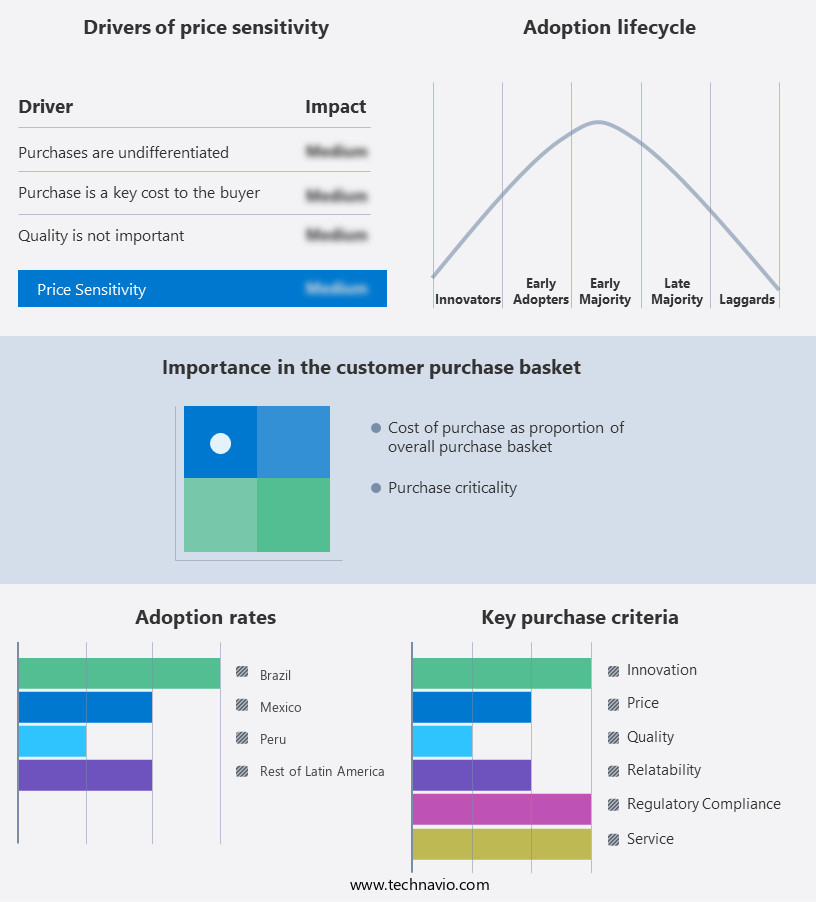
Customer Landscape of Latin America Energy Drinks Market Industry
Key Companies & Market Insights
Companies are implementing various strategies, such as strategic alliances, energy drinks market in latin america forecast, partnerships, mergers and acquisitions, geographical expansion, and product/service launches, to enhance their presence in the market research report.
Alimentos Maravilla SA - The Brazilian beverage company produces and markets a range of energy drinks under the brands Del Frutal, Marinero, and Sipi. These beverages cater to consumers seeking a quick energy boost, featuring distinctive flavors and functional ingredients. The company's success is rooted in its ability to innovate and meet evolving consumer preferences in the global energy drink market.
The market growth and forecasting report includes detailed analyses of the competitive landscape of the market and information about key companies, including:
- Alimentos Maravilla SA
- Anheuser Busch InBev SA NV
- Bebidas Chiamulera
- cbc
- Cervejaria Petropolis SA
- Electrolit USA
- Florida Ice and Farm Company S.A.
- Globalbev Bebidas e Alimentos SA
- Grupo Embotellador ATIC SA
- Hell Energy Hungary Kft.
- MAX ENERGY DRINK
- Monster Energy Co.
- Nova Organic Energy BV
- Organique
- PepsiCo Inc.
- Postobon SA
- Red Bull GmbH
- The Coca Cola Co.
- Wildcat Energy Drink Ltd.
- XITE ENERGY LTD.
Qualitative and quantitative analysis of companies has been conducted to help clients understand the wider business environment as well as the strengths and weaknesses of key industry players. Data is qualitatively analyzed to categorize companies as pure play, category-focused, industry-focused, and diversified; it is quantitatively analyzed to categorize companies as dominant, leading, strong, tentative, and weak.
Recent Development and News in Energy Drinks Market In Latin America
- In January 2024, Red Bull GmbH, the Austrian manufacturer of energy drinks, announced the expansion of its production facility in Brazil. The investment of €100 million (USD113 million) aimed to increase the company's production capacity by 50%, catering to the growing demand in the Latin American market (Red Bull press release).
- In March 2024, Mondelez International, the US-based snack and beverage company, entered into a strategic partnership with Coca-Cola FEMSA, the largest Coca-Cola bottler in Latin America. The collaboration focused on co-branding and marketing of Mondelez's energy drink brand, Monster Energy, in Mexico and other Latin American countries (Mondelez International press release).
- In May 2024, the Brazilian health regulatory agency, Anvisa, approved the sale of energy drinks with higher caffeine content. The new regulation allowed energy drinks with up to 400mg of caffeine per liter, compared to the previous limit of 325mg (Anvisa press release).
- In April 2025, PepsiCo, the US-based food and beverage corporation, launched its energy drink brand, Rockstar, in Argentina. The entry into the Argentine market marked the expansion of Rockstar's presence in Latin America, following its successful launches in Brazil and Colombia (PepsiCo press release).
Research Analyst Overview
- The energy drink market in Latin America continues to evolve, with functional beverage formulations gaining popularity among consumers. Artificial sweetener usage is a significant trend, as brands seek to cater to health-conscious consumers. Market segmentation analysis reveals that millennials and Gen Z demonstrate higher brand loyalty metrics due to their preference for functional beverages. Consumer health concerns and product safety regulations are key drivers shaping the market. Brands are increasingly focusing on ingredient sourcing strategies that prioritize natural and organic ingredients. Product lifecycle management is essential to maintain competitiveness, with continuous innovation and improvement strategies being adopted.
- Functional beverage formulations are a critical aspect of product development, with electrolyte balance and vitamin fortification methods being popular. Herbal extract incorporation and natural flavoring compounds are also gaining traction, as consumers seek healthier alternatives. Market segmentation analysis reveals that distribution channel strategies and manufacturing efficiency improvements are crucial for success. Sales performance indicators, such as pricing strategies effectiveness and packaging material selection, also play a significant role. The energy drink industry is expected to grow by 7% annually, driven by increasing consumer awareness and demand for functional beverages. Product safety regulations and consumer health concerns will continue to shape the market, with brands focusing on transparency and natural ingredient sourcing.
- Brand loyalty metrics and consumer demographics segmentation are essential for effective marketing campaigns and advertising effectiveness. Ingredient sourcing strategies and product innovation strategies will continue to be critical differentiators, with a focus on natural and organic ingredients and functional benefits. Product safety regulations and quality control processes are essential to maintain consumer trust and ensure product safety. Caffeine content regulation and carbonated beverage processing are also key areas of focus for brands. New product development and supply chain optimization are ongoing priorities, with a focus on manufacturing efficiency improvements and sustainable production methods.
- Taste profile optimization and nutritional labeling requirements are also critical areas of focus for brands seeking to differentiate themselves in the market.
Dive into Technavio’s robust research methodology, blending expert interviews, extensive data synthesis, and validated models for unparalleled Energy Drinks Market in Latin America insights. See full methodology.
|
Market Scope
|
|
Report Coverage
|
Details
|
|
Page number
|
147
|
|
Base year
|
2023
|
|
Historic period
|
2018-2022 |
|
Forecast period
|
2024-2028
|
|
Growth momentum & CAGR
|
Accelerate at a CAGR of 13.54%
|
|
Market growth 2024-2028
|
USD 6078.9 million
|
|
Market structure
|
Fragmented
|
|
YoY growth 2023-2024(%)
|
10.9
|
|
Key countries
|
Brazil, Mexico, Peru, and Rest of Latin America
|
|
Competitive landscape
|
Leading Companies, Market Positioning of Companies, Competitive Strategies, and Industry Risks
|
Request Free Sample
What are the Key Data Covered in this Energy Drinks Market in Latin America Research and Growth Report?
- CAGR of the Latin America Energy Drinks Market industry during the forecast period
- Detailed information on factors that will drive the growth and market forecasting between 2024 and 2028
- Precise estimation of the size of the market and its contribution of the industry in focus to the parent market
- Accurate predictions about upcoming growth and trends and changes in consumer behaviour
- Growth of the market across Latin America
- Thorough analysis of the market’s competitive landscape and detailed information about companies
- Comprehensive analysis of factors that will challenge the energy drinks market in latin america growth of industry companies
We can help! Our analysts can customize this energy drinks market in latin america research report to meet your requirements.
Get in touch







![]() Get the report (PDF) sent to your email within minutes.
Get the report (PDF) sent to your email within minutes.
Complimentary full Excel data with your report purchase.